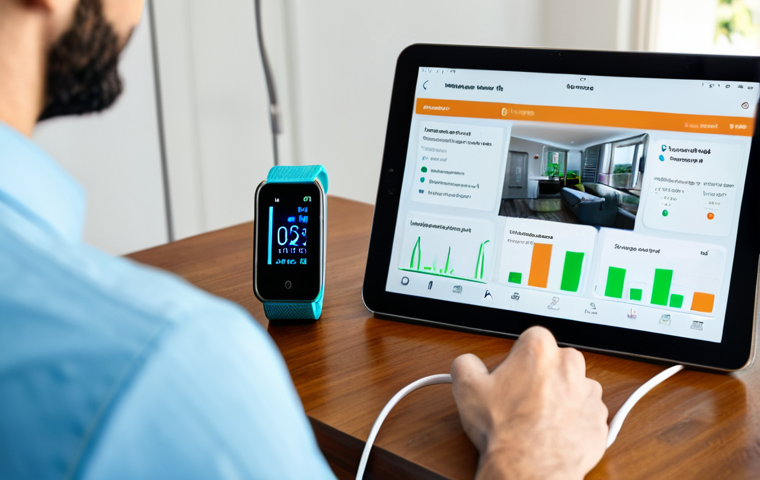In today’s fast-paced world, prioritizing our well-being often takes a backseat. I’ve noticed that so many people, myself included, struggle to find the time and energy to truly focus on their health.
But what if there was a way to proactively manage our well-being with the guidance of a professional? That’s where wellness coordinators and physical health assessments come into play.
From personal experience, having a clear understanding of your body’s current state and working with someone dedicated to your well-being can make a world of difference.
Let’s dig deeper and ensure we understand how these things can play a vital role in our lives. Let’s explore this topic in greater detail below.
## Maximizing Your Health: The Role of Personalized Wellness StrategiesNavigating the complex world of healthcare can be overwhelming. I remember feeling lost when I first started trying to get serious about my health.
It wasn’t until I started working with a health professional that I realized how much I was missing. Personalized wellness strategies are not just about eating right and exercising; it’s about tailoring a plan that fits your unique needs and lifestyle.
Having someone who can guide you through the noise and help you understand your body better is invaluable. I’ve learned that it’s the small, consistent changes that make the biggest difference over time, and having a personalized strategy keeps you on track.
Understanding Your Health Baseline

1. The Importance of Initial Assessment: A comprehensive health assessment is the first step in creating a personalized wellness plan. I recall a friend who thought she was perfectly healthy, but her assessment revealed a vitamin deficiency that was causing her fatigue.
Getting a baseline helps you identify potential issues early on. 2. Key Metrics and Indicators: These assessments often include blood tests, physical exams, and lifestyle questionnaires.
The data gathered provides a holistic view of your current health status. From my experience, understanding your cholesterol levels, blood pressure, and BMI can be incredibly insightful.
3. Setting Realistic Goals: Once you have a clear picture of your health, you can set realistic and achievable goals. This could be anything from losing weight to improving your sleep quality.
Remember, it’s about progress, not perfection.
How Health Navigators Can Transform Your Life
Consider them as guides in your health journey, providing personalized attention that standard healthcare often lacks. My aunt, for instance, always struggled with managing her diabetes until she found a health navigator who helped her understand her dietary needs and monitor her blood sugar levels effectively.
The impact was transformative.
Personalized Support and Guidance
1. Customized Wellness Plans: A health navigator works with you to develop a wellness plan that aligns with your specific health goals and needs. This might include dietary changes, exercise routines, stress management techniques, and more.
2. Motivation and Accountability: Staying motivated can be challenging, especially when you’re trying to make significant lifestyle changes. A health navigator provides ongoing support and accountability to help you stay on track.
3. Education and Resources: They can educate you about various health topics and connect you with valuable resources, such as support groups, health workshops, and specialized medical professionals.
The Financial Benefits of Proactive Health Management
Investing in proactive health management might seem costly upfront, but it can save you money in the long run. Think about it: preventing chronic diseases through healthy lifestyle choices can significantly reduce your healthcare expenses.
Reducing Healthcare Costs
1. Preventing Chronic Diseases: Many chronic diseases, such as diabetes and heart disease, are preventable through lifestyle changes. By managing your health proactively, you can reduce your risk of developing these conditions.
2. Lower Insurance Premiums: Some insurance companies offer discounts for individuals who participate in wellness programs and demonstrate healthy behaviors.
3. Fewer Doctor Visits: When you’re healthy, you’re less likely to need frequent doctor visits and hospitalizations. This can save you a significant amount of money on healthcare costs.
Integrating Technology for Better Health Tracking
Technology has revolutionized the way we manage our health. From wearable fitness trackers to mobile apps, there are countless tools available to help you monitor your progress and stay engaged in your wellness journey.
Using Wearable Devices
1. Tracking Activity Levels: Wearable devices like Fitbit and Apple Watch can track your steps, heart rate, and sleep patterns. This data can provide valuable insights into your daily habits.
2. Monitoring Nutrition: Apps like MyFitnessPal and Lose It! make it easy to track your calorie intake and macronutrient balance.
3. Virtual Consultations: Telehealth platforms allow you to connect with healthcare providers remotely, saving you time and travel costs.
Fostering a Culture of Well-Being in the Workplace
Creating a healthy work environment is essential for employee productivity and morale. Companies that invest in wellness programs often see a reduction in absenteeism and an increase in employee engagement.
I’ve noticed that workplaces that prioritize well-being tend to have a more positive and supportive atmosphere.
Implementing Wellness Programs
1. On-Site Fitness Centers: Providing employees with access to on-site fitness centers can encourage them to exercise regularly. 2.
Healthy Meal Options: Offering healthy meal options in the cafeteria or providing healthy snacks can promote better eating habits. 3. Stress Management Workshops: Conducting stress management workshops can help employees cope with workplace stress and improve their overall well-being.
Additional strategies could include:
* Ergonomic assessments of workstations
* Mental health support services
* Flexible work arrangements to promote work-life balance
Making Informed Decisions: Understanding Health Metrics
Understanding health metrics is crucial for making informed decisions about your health. Metrics like BMI, cholesterol levels, and blood pressure provide valuable insights into your current health status and potential risks.
Key Health Metrics
1. BMI (Body Mass Index): BMI is a measure of body fat based on height and weight. While it’s not a perfect indicator of health, it can provide a general idea of whether you’re at a healthy weight.
2. Cholesterol Levels: Cholesterol levels can indicate your risk of heart disease. It’s important to understand your LDL (bad) cholesterol, HDL (good) cholesterol, and triglyceride levels.
3. Blood Pressure: Blood pressure measures the force of blood against your artery walls. High blood pressure can increase your risk of heart attack, stroke, and other health problems.
Here’s a simple table to illustrate normal ranges for common health metrics:
| Metric | Normal Range | Notes |
|---|---|---|
| BMI | 18.5 – 24.9 | Over 25 is considered overweight |
| Total Cholesterol | Less than 200 mg/dL | Higher levels increase heart disease risk |
| Blood Pressure | Less than 120/80 mmHg | Higher values indicate hypertension |
Long-Term Benefits of Prioritizing Your Well-Being
Prioritizing your well-being is not just about feeling good in the short term; it’s an investment in your long-term health and happiness. The benefits of a healthy lifestyle extend far beyond physical health.
Improved Quality of Life
1. Increased Energy Levels: When you’re healthy, you have more energy to do the things you enjoy. 2.
Better Mental Health: Exercise and healthy eating can improve your mood and reduce your risk of depression and anxiety. 3. Stronger Relationships: When you’re healthy, you’re better able to engage in meaningful relationships with your loved ones.
Maximizing your health involves a journey that’s deeply personal and ever-evolving. When I started prioritizing my wellness, I quickly realized that generic advice often fell short.
It’s about understanding your body, your habits, and your unique needs. Personalized wellness strategies have been a game-changer for me, and I hope the insights shared here can help you on your own path to better health.
Understanding Your Health Baseline
1. The Importance of Initial Assessment: A comprehensive health assessment is the bedrock of any personalized wellness plan. I remember when I first moved to a new city, finding a doctor who took the time to understand my health history made all the difference.
An initial assessment sets the stage for identifying potential issues early. 2. Key Metrics and Indicators: These assessments typically involve blood tests, physical exams, and lifestyle questionnaires.
The data paints a holistic picture of your current health status. For example, understanding your Vitamin D levels or thyroid function can be incredibly insightful.
3. Setting Realistic Goals: Once you have a clear understanding of your health, you can set realistic and achievable goals. This could range from incorporating more greens into your diet to hitting the gym three times a week.
Remember, it’s about building sustainable habits.
How Health Navigators Can Transform Your Life
Think of health navigators as your personal guides in the labyrinthine world of healthcare. They provide tailored attention that standard care often overlooks.
A colleague of mine struggled with anxiety until she connected with a health navigator who introduced her to mindfulness techniques and cognitive behavioral therapy.
The transformation was remarkable.
Personalized Support and Guidance

1. Customized Wellness Plans: A health navigator partners with you to create a wellness plan aligned with your specific health goals and needs. This might encompass dietary adjustments, exercise regimens, stress management practices, and more.
2. Motivation and Accountability: Staying motivated can be a real challenge, especially when striving to make significant lifestyle changes. A health navigator offers continuous support and accountability to keep you on track.
3. Education and Resources: They can educate you about various health topics and link you with valuable resources, like support groups, health workshops, and specialized medical professionals.
The Financial Benefits of Proactive Health Management
While investing in proactive health management might seem costly initially, it can save you money in the long run. Consider this: preventing chronic diseases through healthy lifestyle choices can significantly reduce your healthcare expenses.
Reducing Healthcare Costs
1. Preventing Chronic Diseases: Many chronic diseases, such as type 2 diabetes and cardiovascular disease, are preventable through lifestyle adjustments.
By managing your health proactively, you can lower your risk of developing these conditions. 2. Lower Insurance Premiums: Some insurance companies offer discounts for individuals who participate in wellness programs and demonstrate healthy behaviors.
3. Fewer Doctor Visits: When you’re healthy, you’re less likely to need frequent doctor visits and hospitalizations, leading to significant savings on healthcare costs.
Integrating Technology for Better Health Tracking
Technology has revolutionized how we manage our health. From wearable fitness trackers to mobile apps, numerous tools are available to help you monitor your progress and stay engaged in your wellness journey.
Using Wearable Devices
1. Tracking Activity Levels: Wearable devices like Fitbit and Apple Watch can track your steps, heart rate, and sleep patterns, providing valuable insights into your daily habits.
2. Monitoring Nutrition: Apps like MyFitnessPal and Lose It! simplify tracking your calorie intake and macronutrient balance.
3. Virtual Consultations: Telehealth platforms enable you to connect with healthcare providers remotely, saving you time and travel costs.
Fostering a Culture of Well-Being in the Workplace
Creating a healthy work environment is essential for employee productivity and morale. Companies that invest in wellness programs often see a reduction in absenteeism and an increase in employee engagement.
In my experience, workplaces that prioritize well-being tend to have a more positive and supportive atmosphere.
Implementing Wellness Programs
1. On-Site Fitness Centers: Providing employees with access to on-site fitness centers can encourage them to exercise regularly. 2.
Healthy Meal Options: Offering healthy meal options in the cafeteria or providing healthy snacks can promote better eating habits. 3. Stress Management Workshops: Conducting stress management workshops can help employees cope with workplace stress and improve their overall well-being.
Additional strategies could include:
* Ergonomic assessments of workstations
* Mental health support services
* Flexible work arrangements to promote work-life balance
Making Informed Decisions: Understanding Health Metrics
Understanding health metrics is crucial for making informed decisions about your health. Metrics like BMI, cholesterol levels, and blood pressure provide valuable insights into your current health status and potential risks.
Key Health Metrics
1. BMI (Body Mass Index): BMI is a measure of body fat based on height and weight. While it’s not a perfect indicator of health, it can provide a general idea of whether you’re at a healthy weight.
2. Cholesterol Levels: Cholesterol levels can indicate your risk of heart disease. It’s important to understand your LDL (bad) cholesterol, HDL (good) cholesterol, and triglyceride levels.
3. Blood Pressure: Blood pressure measures the force of blood against your artery walls. High blood pressure can increase your risk of heart attack, stroke, and other health problems.
Here’s a simple table to illustrate normal ranges for common health metrics:
| Metric | Normal Range | Notes |
|---|---|---|
| BMI | 18.5 – 24.9 | Over 25 is considered overweight |
| Total Cholesterol | Less than 200 mg/dL | Higher levels increase heart disease risk |
| Blood Pressure | Less than 120/80 mmHg | Higher values indicate hypertension |
Long-Term Benefits of Prioritizing Your Well-Being
Prioritizing your well-being is not just about feeling good in the short term; it’s an investment in your long-term health and happiness. The benefits of a healthy lifestyle extend far beyond physical health.
Improved Quality of Life
1. Increased Energy Levels: When you’re healthy, you have more energy to do the things you enjoy. 2.
Better Mental Health: Exercise and healthy eating can improve your mood and reduce your risk of depression and anxiety. 3. Stronger Relationships: When you’re healthy, you’re better able to engage in meaningful relationships with your loved ones.
In Closing
Embarking on a personalized wellness journey is a deeply rewarding experience that goes beyond just physical health. It’s about gaining a deeper understanding of yourself, making informed decisions, and building habits that support a vibrant and fulfilling life. I hope this guide has provided you with actionable insights and inspiration to take charge of your health and well-being. Here’s to a healthier, happier you!
Good to Know Info
1. Always consult with a healthcare professional before making significant changes to your diet or exercise routine. They can provide personalized guidance based on your individual health needs.
2. Consider joining local health and wellness groups. These communities can provide valuable support, encouragement, and resources for staying on track with your wellness goals.
3. Explore the benefits of mindful eating. Paying attention to your body’s hunger and fullness cues can help you develop a healthier relationship with food.
4. Prioritize sleep. Aim for 7-9 hours of quality sleep each night to support your physical and mental health. Establishing a consistent sleep schedule can make a big difference.
5. Stay hydrated. Drinking enough water throughout the day is essential for overall health. Carry a reusable water bottle and sip on it regularly to stay hydrated.
Key Takeaways
Personalized wellness strategies are essential for maximizing your health.
Health navigators can provide invaluable support and guidance.
Proactive health management can lead to significant financial benefits.
Technology can be a powerful tool for tracking your health and progress.
Prioritizing well-being is an investment in your long-term health and happiness.
Frequently Asked Questions (FAQ) 📖
Q: What exactly does a wellness coordinator do and why should I even consider working with one?
A: Okay, so a wellness coordinator is like your personal guide to feeling awesome, but in a sustainable way. They’re not just about pushing diets or quick fixes.
Instead, they take a look at your entire life – work, stress levels, sleep, eating habits – and help you create a realistic plan to improve your well-being.
Think of it like having a personal trainer for your whole life, not just your muscles. Why bother? Well, I used to drag myself through the day, surviving on coffee and stress.
After working with a wellness coordinator for just a few months, I felt genuinely energized, more focused, and less prone to catching every bug that went around.
It’s an investment in yourself, really. They can help you navigate the often-confusing world of health and wellness so you are focusing on what matters to you and your own personal health goals.
Q: What does a physical health assessment entail, and is it really necessary if I feel “fine?”
A: A physical health assessment is basically a comprehensive check-up on your body’s current status. It goes beyond your annual doctor’s visit. It usually includes things like blood pressure checks, cholesterol screening, body composition analysis, maybe even a stress test or a look at your fitness level.
Is it necessary if you feel “fine”? That’s like asking if you need to change the oil in your car before it breaks down – prevention is always better (and cheaper!) than cure!
From what I’ve seen, lots of people walk around with underlying issues they don’t even know about. I thought I was perfectly healthy until a health assessment revealed I was pre-diabetic.
It gave me the motivation I needed to tweak my diet and exercise routine before it became a serious problem.
Q: How do I find a reputable wellness coordinator or find out about physical health assessment options in my area?
A: Finding a good wellness coordinator or figuring out your health assessment options takes a little digging, but it’s totally worth it. Start by asking your primary care doctor for recommendations; they often have partnerships with local wellness programs.
Also, your health insurance provider might offer coverage or discounts for working with a wellness coordinator or getting certain screenings. Beyond that, a quick online search for “wellness coordinators [your city/town]” or “physical health assessments near me” can turn up some options.
Just be sure to check reviews, look for certifications (like Certified Wellness Professional), and maybe even schedule a quick call to see if they’re a good fit for your personality and goals.
Remember, it’s about your health and finding someone who understands and supports your individual needs!
📚 References
Wikipedia Encyclopedia






